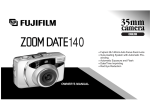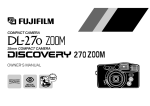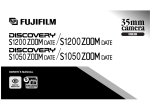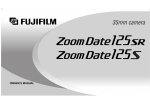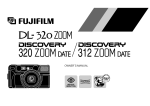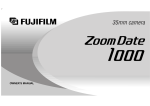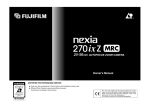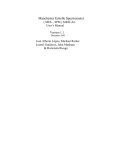Download Fuji Big Viewfinder Date 35 35mm Point and Shoot Camera
Transcript
ENGLISH , OWNER S MANUAL CONTENTS PART NAMES ........................................................................... 3 YOUR NEW FUJIFILM CAMERA 1. FIRST STEPS ATTACHING THE STRAP ........................................................ 6 LOADING THE BATTERIES .................................................... 7 TURNING ON YOUR CAMERA ............................................... 9 SETTING THE DATE (YEAR-MONTH-DAY/HOUR-MINUTE) (for BIG VIEWFINDER DATE 35/CLEAR SHOT 20 DATE only) .. 10 SELECTING THE DATE MODE (for BIG VIEWFINDER DATE 35/CLEAR SHOT 20 DATE only) .. 12 Welcome to the world of FUJIFILM photography. Your new FUJIFILM BIG VIEWFINDER DATE 35/BIG VIEWFINDER AUTO 35/CLEAR SHOT 20 DATE/CLEAR SHOT 20 AUTO will open a new world of photographic fun as you take pictures to record memorable events or to express yourself. Some of the features which make taking successful pictures easier than ever include: 2. USING YOUR CAMERA LOADING THE CAMERA ....................................................... 13 USING YOUR FINDER ........................................................... 18 USING YOUR CAMERA ......................................................... 19 UNLOADING THE FILM OR REMOVING FILM IN MID-ROLL ....... 24 TROUBLE SHOOTING ........................................................... 26 COMMON SENSE CAMERA CARE ...................................... 28 SPECIFICATIONS .................................................................. 29 2 • Autofocus – To assure sharp, clear pictures • Automatic Flash – To provide lighting at any time for bright, wellexposed pictures • Easy Film Loading – Fool-proof operation to minimize handling mistakes • Auto Film Advance – Permits you to concentrate on your subject, not on camera handling • Date/Time Imprinting – For a timely, permanent record to add value to your pictures (for BIG VIEWFINDER DATE 35/CLEAR SHOT 20 DATE only) • Bright, Clear Viewfinder – Gives you a clear view of what your camera sees • Red Eye Reduction – For better pictures of people The “CE” mark certifies that this product satisfies the requirements of the EU (European Union) regarding safety, public health, environment and consumer protection.(“CE” is the abbreviation of Conformité Européenne.) This product is in conformity with Directive 89/336/EEC. PART NAMES 1 (→p.17) 5 (→p.21) 2 (→p.21) 3 6 (→p.22) 1 2 3 4 5 6 7 8 9 Exposure Counter Shutter Release Button AE Light Sensor Strap Lug Red-eye Reduction Lamp Flash Viewfinder Window Fujinon Lens/ Lens Cover Lens Cover Tab 7 8 (→p.9) 4 (→p.6) 9 (→p.9) 3 0 (→p.18) A (→p.9) E (→p.10, 12) F (→p.14) B (→p.14, 25) C (→p.14, 25) H (→p.7) G (→p.24) I (→p.11) J (→p.10) 4 D K (→p.10, 12) 0 A B C D E F G H Viewfinder Eye-piece Flash Ready Lamp Camera Back Camera Back Lock Tripod Socket Date Display∗ Film Confirmation Window Mid-Roll Rewind Switch Battery Compar tment Cover I ADJ Button∗ J SEL Button∗ K MODE Button∗ ∗: for BIG VIEWFINDER DATE 35/CLEAR SHOT 20 DATE only Liquid Crystal Display (for BIG VIEWFINDER DATE 35/CLEAR SHOT 20 DATE only) L Month Display M Date/Time Imprinting N Date Display L (→p.10, 12) M (→p.12) N (→p.10, 12) 5 1 1. FIRST STEPS ATTACHING THE STRAP Slip the thin cord on the carrying strap through the strap lug on the side of the camera leaving a loop. Slide the thick part of the strap through this loop and pull tight. Take up any slack to make sure the strap is securely attached to the camera. Do not use a strap made for cellular phones or similar electronic products. These straps are usually too light to hold your camera securely. Use straps designed for cameras for safety. 2 6 LOADING THE BATTERIES 1 Make sure you have the correct batteries for your camera. The BIG VIEWFINDER DATE 35/BIG VIEWFINDER AUTO 35/CLEAR SHOT 20 DATE/CLEAR SHOT 20 AUTO uses two alkaline batteries (size AA/LR6) for reliable service. Do not use other types of batteries. To load batteries ... Open the battery compartment cover by pressing against the finger rest and sliding the cover in the direction of the arrow. 2 2 1 1 Insert the batteries following the instructions in the diagram on the inside of the battery cover. It is important to pay attention to the position of the , and - poles of the batteries. If the batteries are not inserted correctly, the camera will not operate. 2 Once the batteries are correctly inserted, close the battery compartment cover by snapping it into place. When the cover is closed properly, it fits flush against the bottom of the camera. 7 ∗ ∗ ∗ ∗ ∗ ∗ ∗ ∗ 8 Do not apply excessive force when opening the battery cover. Make sure that the new batteries are both the same brand and type. Do not use Ni-Cd batteries. Two alkaline batteries should be sufficient for approximately 600 exposures (based on our test conditions). When traveling, take extra batteries to provide power for extra exposures, particularly important if you visit areas where fresh batteries may be difficult to obtain. At low temperatures, battery capacity is reduced. Warm the batteries, e.g. in your pocket, before using them. After changing batteries, reset the date to assure accurate date/time recording. (for BIG VIEWFINDER DATE 35/CLEAR SHOT 20 DATE only →p.10) Do not load film before inserting the batteries into the camera. 1 TURNING ON YOUR CAMERA Before you can starting taking pictures, you must turn on your camera. To do this, slide the lens cover in the “ ” direction so that the lens is uncovered. ☞ When the camera is turned on the flash ready lamp will light up. When turning the camera on, do not touch the lens area. 2 ● ∗ ∗ ∗ Flash ready lamp The flash ready lamp will light up once the flash has been recharged. If it takes longer than 20 seconds for the flash ready lamp to light up, replace the batteries. If you leave the camera alone for about 1-3 minutes, the flash ready lamp will turn off. • Nevertheless, since the flash has been recharged you can still take a picture. • If you press the shutter release button halfway, the flash ready lamp will light up again. You can then confirm that the flash has been recharged. 9 SETTING THE DATE (YEAR-MONTH-DAY/HOUR-MINUTE) 1 (for BIG VIEWFINDER DATE 35/CLEAR SHOT 20 DATE only) Setting the Date 1 Press the MODE button and “ 2 Press the SEL button. ” to display the year, month and day. ☞ The numerals will blink and the camera will enter the date setting mode. ∗ The numeral under the “ ” in the display area indicates the month. 1 2 Setting the Time 1 Press the MODE button to display the hour and minute. 2 Press the SEL button. ☞ The numerals will blink and the camera will enter the time setting mode. ∗ The date cannot be changed at this stage. The date changes along with the time. To display both correctly, set the date and time together. 1 2 10 1 Press the ADJ button to change the blinking setting. 2 Press the SEL button to select the next part of the date/time information. 2 You can set: Year :’98 to ’49 (1998 to 2049) Month :1 to 12 Day : 1 to 31 Time :0 to 23 hours; 00 to 59 minutes ● 21 3 Once the date and time are set, press the SEL button and setting will cease. ☞ To set the time (hour or minute) by the radio, set the correct time using the time correction mode, and press in the SEL button when the time signal indicates zero. 11 SELECTING THE DATE MODE (for BIG VIEWFINDER DATE 35/CLEAR SHOT 20 DATE only) The date and time (year-month-day/ hour-minute) will be imprinted at the lower right of the photograph. ∗ The date display printed on the front of the picture may not be clearly visible against a dark background. Y : Year M : Month D : Day T : Time With each press of the MODE button, the date mode changes as in the illustration. YMD DT M DY D MY 12 _ ☞ The date and time will be printed based on the mode you select. ∗ ∗ ∗ If “ ” is showing in the upper right of the display area, the date will be imprinted on the photograph. The numeral under the “ ” in the display area indicates the month. If “- - - - - -” is chosen, no date will appear on the photograph. 2. USING YOUR CAMERA A LOADING THE CAMERA B C Your camera uses standard 35mm film available anywhere. Almost all 35mm films will have a DX coding symbol on the film box and on the cassette itself. Information you will see includes: A : Number of Exposures B : DX Code symbol C : Film Speed (sensitivity to light expressed as the ISO rating) Use only 35 mm films with ISO ratings of 100, 200 or 400. Films rated at ISO 400 will provide the extra speed to extend your picture-taking day and can be considered your best all-round choice. • If non-DX coded film is used, the camera’s automatic exposure system automatically sets itself to ISO 100. • Always load and remove film from your camera away from direct sunlight. 13 Check the film check window to make sure no film is loaded into the camera. 1 ∗ ∗ 1 Slide the camera back lock in the direction indicated by the arrow. 2 To open the back, slide the lock in the direction indicated by the arrow. 2 ∗ 2 1 14 Insert batteries before loading film. Never open the camera back while film is in your camera. Never apply excessive force when opening or closing the camera back. 3 4 Insert the roll of film. A : INDEX mark While holding the film cassette down, pull the end of the film leader out as far as the index mark. ∗ If you pull the film too far out of the canister, remove the film and adjust the length. A 15 5 6 16 Adjust the angle of the film cassette so that it does not pop out. Close the camera back. ∗ The type, number of exposures, and speed of the film that has been loaded may be checked with the film check window. 7 8 Open the lens cover. Press the shutter release button until the exposure counter displays “1”. Cover the lens with your hand when doing so. If “1” is not displayed in the exposure counter, the film is not advancing. Load the film again. 17 USING YOUR FINDER (BRIGHT FRAME) The large viewfinder of your FUJIFILM camera makes it easier it easier to take better, more interesting pictures. The finder includes: A A : Bright Frame Lines Your picture will include enerything you see within the frame lines. 18 1 USING YOUR CAMERA Open the lens cover. Before taking important, once-in-a-lifetime pictures such as weddings or special events, take a few test shots to make sure your camera is functioning correctly. If you purchased your camera before going on a trip, shoot a roll or two to familiarize yourself with the operation of the camera. And don’t forget to get an extra set of batteries. You should also keep this instruction book with you for handy reference. 2 Check whether the flash ready lamp is on. ∗ If the flash ready lamp is off, press the shutter release halfway for a moment. If the flash ready lamp does not light up after 20 seconds have passed, replace the batteries. 19 3 4 20 Hold your camera firmly using both hands as shown in the illustration. When taking vertical pictures, hold your camera with the flash unit at the top. ∗ Make sure that nothing is in front of the lens, the flash or the automatic exposure light sensor. Place your fingers as shown in the illustration. Aim at your subject so that it is covered by the framing area. ∗ The focusing range for sharp pictures is from 1.0 m (3.3 ft.) to infinity. Press down the shutter release button halfway. 5 ☞ The red-eye reduction lamp lights up. ☞ The flash ready lamp turns off. Press the shutter release button down completely. 6 ☞ The film advances to the next frame. ☞ The number shown in the exposure counter increases by 1 with each frame photographed. 3 1 21 Under low light when flash must be used, the following chart gives you the effective flash range for correct exposures for films of various speeds. Note that high-speed film (ISO 400) extends your flash range significantly. Film speed ISO 100 ISO 200 ISO 400 Effective flash range 1.0 – 2.5 m 3.3 – 8.2 ft. 1.0 – 3.6 m 3.3 – 11.8 ft. 1.0 – 5.0 m 3.3 – 16.4 ft. (Using color negative film) 22 Dealing with red-eye When you photograph a person in dim light using flash, the pupil of the eye will sometimes appear red. Under low light, the pupils of the eye dilate for better vision. Red-eye is caused by light from the flash entering the dilated pupils and being reflected back to the lens. Red-eye reduction causes a preliminary flash to fire before the actual picture is taken. This causes the pupil to contract, reducing this reflection. When the actual flash exposure is made, the degree of reflection is minimized, thus reducing red-eye. When using red-eye reduction: ● Press the shutter release button halfway. When the red-eye reduction lamp comes on, wait 1 second or more and then take your photograph. ● Ask your subject to look directly into the camera. ● Approach as closely as possible to make your exposure. 23 UNLOADING THE FILM OR REMOVING FILM IN MID-ROLL Never open the camera back while film is in your camera. If the camera back comes open, close it without removing the film. ☞The exposure counter will be reset to “S.” ☞The film will be exposed, but depending on the circumstances, if you advance the film 2 or 3 frames, you may be able to take photographs. 1 When you have taken the designated number of photographs, or wish to remove the film in mid-roll, slide the rewind switch in the direction indicated by the arrow and rewind the film. ☞ When all the frames on the film have been exposed, the shutter release button will not longer ∗ 24 operate. Under some circumstances you may be able to take more than the designated number of photographs. However, the final frame may not print in some cases. When the motor stops rewinding, check to make sure the exposure counter shows “ S ”. 2 To make sure that your roll of film which has been completely exposed is not accidentally exposed to light, make sure the exposure counter reads “S” before opening the camera back. 3 3 1 Slide the camera back lock in the direction indicated by the arrow. 2 Open the camera back in the direction indicated by the arrow. 3 Remove the film. ∗ Do not apply unnecessary force to the camera back. 2 1 25 TROUBLE SHOOTING During operation Problems The shutter release won’t trip. Possible Causes 1 Is the lens cover closed? 2 Is the flash ready lamp off? 3 Have all the frames on the film been exposed? 26 Solutions Page 1 Turn on the power by opening the lens cover and set the camera to the ready-to-shoot state. 2 If the flash ready lamp has not come on 20 seconds or more after the power is turned on or the shutter release is tripped, replace the batteries. 3 Remove the film, and load an unexposed roll. 9 24 ● Be sure not to move the film rewind switch while 24 9 The film rewound during photographing. ● Did you slide the rewind switch in mid- After loading the film and closing the back cover, the exposure counter does not advance. ● Did you load the film properly? ● Load the film correctly. 13 The camera back will not close. ● Is the film cassette in straight? ● After straightening the film cassette, close the 16 roll? film is loaded in the camera. camera back. Printed pictures Problems Possible Causes Solutions Page 1 Did you take the picture from a distance less than 1.0 m (3.3 ft.)? 2 Is the lens dirty? 3 Is the camera moving? 1 Move more than 1.0 m (3.3 ft.) away and take the picture. 2 Clean the lens. 3 Hold the camera firmly and press the shutter release button gently. 20 1 Subject was too far from the camera for flash photography in a dark place. 2 Was your finger over the flash? 1 Shoot within specified coverage distance of electronic flash. 2 Do not cover the flash with your finger. 22 Printed date/time is incorrect. (for BIG VIEWFINDER DATE 35/CLEAR SHOT 20 DATE only) ● You didn’t set correct date and time ● Set date and time after replacing batteries. 10 The date is not printed on the front. (for BIG VIEWFINDER DATE 35/CLEAR SHOT 20 DATE only) 1 Wasn’t “- - - - - -” selected before taking pictures? 2 Is there something light-colored (white, yellow, orange) where the date appears? 1 Select a date mode other than “- - - - - -” before taking pictures. 2 Try to arrange that there is nothing light-colored where the date appears. 12 Picture is not sharp. Picture is too dark. 28 20 20 after replacing batteries. 12 27 COMMON SENSE CAMERA CARE 1 Although your camera is designed for many years of service, it is a precision instrument and requires thoughtful handling. In particular, avoid exposing it to shock, moisture or physical abuse such as dropping it on the floor. 1 If you use your camera at the beach or in a light rain, protect it from moisture. Do not let your camera get wet. Be particularly careful to avoid sand and salt spray at the beach. 2 Dropping your camera or letting it strike a hard surface could result in damage even though the camera was in a case. Never subject the camera to vibration such as in the trunk of a car. Never keep your camera in the trunk or the glove compartment of a car: the heat build-up can damage it. 2 28 If you will not be using your camera for some time, store it where it will be safe from heat, moisture, dust and harmful gases such as napthalene (moth balls and moth flakes). 3 Never store the camera in a closed automobile for an extended period. 4 It is recommended that undeveloped film and cameras containing film be carried as hand luggage when flying. If included in checked-in baggage, X-ray inspections may cause overprinting or other effects. 5 Remove soil and dust from the lens and the finder with an air blower and by wiping lightly with a piece of soft cloth. If that is not enough, wipe off gently with Lens Cleaning Paper, moistened slightly with Lens Cleaning Liquid. Do not use organic solvents such as alcohol and benzene. 6 Dust and debris in the film compartment can scratch the film. Use a blower brush to clean it. 7 8 Load and remove film away from direct sunlight. 9 Since the performance of the battery will drop in cold weather, warm the battery by placing it inside your garments, etc. before use. The performance of a battery whose performance has temporarily dropped can be restored by returning the battery to normal temperature. The operating temperature range of the camera is from –5°C to +40°C. With a few common sense precautions, your camera will give you years of faithful service, great pleasure and wonderful pictures. SPECIFICATIONS • Film • Film Advance 135 (35 mm) DX roll film • Picture Size 24 mm × 36 mm • Lens Fujinon lens, 3 components, 3 elements, f=28.5 mm 1:5.6 • Viewfinder Inverted Galilean Albada finder with bright frame, 0.63 × magnification • Focusing 1.0 m/3.3 ft. – • Shutter Release Mechanical shutter release, Fixed at 1/100 sec. • Film Speed Setting Automatic (DX roll film) for speeds from ISO 100/200, 400 • Film Loading Automatic Automatic (motorized), film wind and rewind system (by the rewind switch), provision for mid-roll rewinding • Flash Build-in auto flash, 8 seconds recycle time, with red-eye reduction (when shutter release button is pressed halfway down) • Power Supply Two alkaline batteries (LR6/AA size) or comparable battery • Others Tripod socket, shutter realease safety lock and flash recycle safety turned on by closing the lens cover • Dimensions & Weight ∞ • BIG VIEWFINDER DATE 35/CLEAR SHOT 20 DATE 110.0 × 67.5 × 41.5 mm/4.3 × 2.7 × 1.6 in. (main unit), 150 g/5.3 oz. (without battery) • BIG VIEWFINDER AUTO 35/CLEAR SHOT 20 AUTO 110.0 × 67.5 × 38.0 mm/4.3 × 2.7 × 1.5 in. (main unit), 140 g/4.9 oz. (without battery) ∗ Specifications are subject to change without notice. 29 26-30, Nishiazabu 2-chome, Minato- ku, Tokyo 106-8620, Japan. <FUJIFILM ABROAD> In North America FUJI PHOTO FILM U.S.A., INC. 555 Taxter Road, Elmsford, N.Y. 10523, U.S.A. FUJI PHOTO FILM CANADA INC. 275 Britannia Road East, Mississauga, Ontario , L4Z 2E7, Canada FUJI PHOTO FILM HAWAII, INC. 1650 Kalakaua Avenue, Honolulu, Hawaii 96826, U.S.A. In Europe FUJI PHOTO FILM (EUROPE) G.m.b.H. Heesenstrasse 31, 40549 Dusseldorf, Germany FUJI PHOTO FILM (U.K.) LTD. Fuji Film House, 125 Finchley Road, Swiss Cottage, London NW3 6JH, England FUJI FILM ESPAÑA, S.A. Aragon, 180, 08011-Barcelona, Spain In South America FUJI PHOTO FILM DO BRAZIL LTDA. Avenida Vereador Jose Diniz No. 3.400, Campo Belo- CEP 04.604 Cx. Postal 9.959., Sao Paulo-SP, Brazil In Asia FUJI PHOTO FILM CO., LTD., HONG KONG OFFICE Room 916, Sun Plaza, 28 Canton Road, Tsim Sha Tsui, Kowloon, Hong Kong FUJI PHOTO FILM (SINGAPORE) PTE. LTD. 10 New Industrial Road, Singapore 536201 FUJI PHOTO FILM (THAILAND) LTD. S.P. Building, 8th Floor, 388 Phaholyothin Road, Bangkok 10400, Thailand FUJI PHOTO FILM (MALAYSIA) SDN. BHD. Letter Box 3, 3rd Floor Office Block 1, Crystal Plaza Lot 4, Jalan 51A/223, 46100 Petaling Jaya Selangor Darul Ehsan Malaysia FUJI PHOTO FILM CO., LTD., TAIPEI OFFICE Rm. 601, Hung Chong Bldg., No.38, Sec. 6, Min Chuan E. Road, Taipei 11412, Taiwan, Republic of China FUJI PHOTO FILM CO., LTD., SEOUL OFFICE Samduck Bldg. 6F., 144-1, Samsung-Dong, Kang Nam-ku, Seoul 135-090, Korea FUJI PHOTO FILM CO., LTD., BEIJING REPRESENTATIVE OFFICE Beijing Fortune Bldg. No. 817, 5, Dong Sanhuan Bei-lu, Chaoyang District, Beijing, China 100004 FUJI PHOTO FILM CO., LTD., HO CHI MINH OFFICE 29-31 Ton That Thiep St., Q.I Ho Chi Minh City, Vietnam FUJI PHOTO FILM CO., LTD., NEW DELHI OFFICE Le Meridian Commercial Tower 8F Janpath, New Delhi 110001, India In Oceania FUJI PHOTO FILM CO., LTD., SYDNEY REPRESENTATIVE OFFICE c/o Hanimex Pty. Limited, Old Pittwater Road, Brookvale, N.S.W. 2100, Australia In Middle East FUJI PHOTO FILM CO., LTD., DUBAI OFFICE No. 4G-17, L.O.B. No. 4, P.O. BOX 17212, Jebel Ali, Dubai, U.A.E. Printed in China FGS-002107-P-01































